The document provides an overview of principles of programming languages, including:
- Reasons for studying programming language concepts such as improved ability to learn new languages.
- Categories of programming languages including imperative, functional, logic, and object-oriented languages.
- Factors that influence language design such as computer architecture and programming methodologies.
- Methods of describing syntax including Backus-Naur Form and context-free grammars. Attribute grammars add semantic information to parse trees.
- Implementation methods for languages including compilation, interpretation, and hybrid systems.
![G. NARAYANAMMA INSTITUTE OF TECHNOLOGY & SCIENCE
(For Women) Autonomous
DEPARTMENT OF IT
Principles of Programming Language
Prepared by: Dr.I.Ravi Prakash Reddy, HOD IT Email: irpreddy@gnits.ac.in
UNIT-I
Preliminaries
Topics
1. Reasons for Studying Concepts of Programming Languages
2. Programming Domains
3. Language Evaluation Criteria
4. Influences on Language Design
5. Language Categories
6. Language Design Trade-Offs
7. Implementation Methods
8. Programming Environments
`
Background
―Frankly, we didn‘t have the vaguest idea how the thing [FORTRAN language
and compiler] would work out in detail. …We struck out simply to optimize the object
program, the running time, because most people at that time believed you couldn‘t do
that kind of thing. They believed that machined-coded programs would be so
inefficient that it would be impractical for many applications.‖
-John Backus
Unexpected successes are common – the browser is another example of an
unexpected success
1.1 Reasons for Studying Concepts of Programming Languages
Increased ability to express ideas
Improved background for choosing appropriate languages
Increased ability to learn new languages
Better understanding of significance of implementation
Overall advancement of computing
1.2 Programming Domains
• Scientific applications
– Large number of floating point computations
– Fortran
• Business applications
– Produce reports, use decimal numbers and characters
– COBOL
• Artificial intelligence
– Symbols rather than numbers manipulated
– LISP
• Systems programming
– Need efficiency because of continuous use](https://image.slidesharecdn.com/ppl-150324230515-conversion-gate01/85/Principles-of-programming-languages-Detail-notes-1-320.jpg)

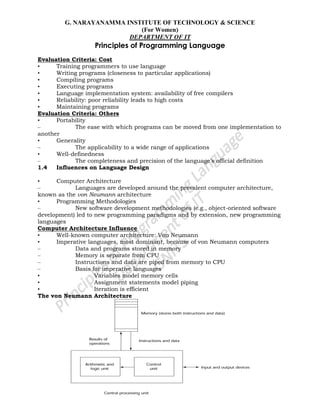






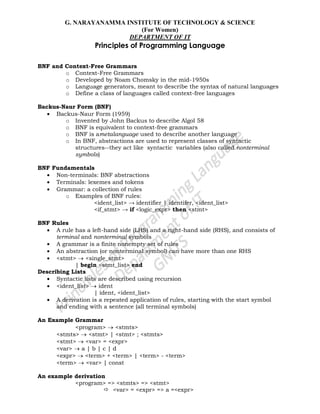


![G. NARAYANAMMA INSTITUTE OF TECHNOLOGY & SCIENCE
(For Women)
DEPARTMENT OF IT
Principles of Programming Language
Extended BNF
Optional parts are placed in brackets ([ ])
<proc_call> -> ident [(<expr_list>)]
Alternative parts of RHSs are placed inside parentheses and separated via
vertical bars
<term> → <term> (+|-) const
Repetitions (0 or more) are placed inside braces ({ })
<ident> → letter {letter|digit}
BNF and EBNF
BNF
<expr> <expr> + <term>
| <expr> - <term>
| <term>
<term> <term> * <factor>
| <term> / <factor>
| <factor>
EBNF
<expr> <term> {(+ | -) <term>}
<term> <factor> {(* | /) <factor>}
2.4 Attribute Grammars
Context-free grammars (CFGs) cannot describe all of the syntax of programming
languages
Additions to CFGs to carry some semantic info along parse trees
Primary value of attribute grammars (AGs):
o Static semantics specification
o Compiler design (static semantics checking)
Attribute Grammars : Definition
An attribute grammar is a context-free grammar G = (S, N, T, P) with the](https://image.slidesharecdn.com/ppl-150324230515-conversion-gate01/85/Principles-of-programming-languages-Detail-notes-13-320.jpg)
![G. NARAYANAMMA INSTITUTE OF TECHNOLOGY & SCIENCE
(For Women)
DEPARTMENT OF IT
Principles of Programming Language
following additions:
o For each grammar symbol x there is a set A(x) of attribute values
o Each rule has a set of functions that define certain attributes of the
nonterminals in the rule
o Each rule has a (possibly empty) set of predicates to check for attribute
consistency
o Let X0 X1 ... Xn be a rule
o Functions of the form S(X0) = f(A(X1), ... , A(Xn)) define synthesized
attributes
o Functions of the form I(Xj) = f(A(X0), ... , A(Xn)), for i <= j <= n, define
inherited attributes
o Initially, there are intrinsic attributes on the leaves
Attribute Grammars: Example
Syntax
<assign> -> <var> = <expr>
<expr> -> <var> + <var> | <var>
<var> A | B | C
actual_type: synthesized for <var> and <expr>
expected_type: inherited for <expr>
Syntax rule: <expr> <var>[1] + <var>[2]
Semantic rules:
<expr>.actual_type <var>[1].actual_type
Predicate:
<var>[1].actual_type == <var>[2].actual_type
<expr>.expected_type == <expr>.actual_type
Syntax rule: <var> id
Semantic rule:
<var>.actual_type lookup (<var>.string)
How are attribute values computed?
o If all attributes were inherited, the tree could be decorated in top-down
order.
o If all attributes were synthesized, the tree could be decorated in bottom-
up order.
o In many cases, both kinds of attributes are used, and it is some
combination of top-down and bottom-up that must be used.
<expr>.expected_type inherited from parent
<var>[1].actual_type lookup (A)](https://image.slidesharecdn.com/ppl-150324230515-conversion-gate01/85/Principles-of-programming-languages-Detail-notes-14-320.jpg)
![G. NARAYANAMMA INSTITUTE OF TECHNOLOGY & SCIENCE
(For Women)
DEPARTMENT OF IT
Principles of Programming Language
<var>[2].actual_type lookup (B)
<var>[1].actual_type =? <var>[2].actual_type
<expr>.actual_type <var>[1].actual_type
<expr>.actual_type =? <expr>.expected_type
2.5 Semantics
There is no single widely acceptable notation or formalism for describing
semantics
Operational Semantics
o Describe the meaning of a program by executing its statements on a
machine, either simulated or actual. The change in the state of the
machine (memory, registers, etc.) defines the meaning of the statement
To use operational semantics for a high-level language, a virtual machine is
needed
A hardware pure interpreter would be too expensive
A software pure interpreter also has problems:
o The detailed characteristics of the particular computer would make
actions difficult to understand
o Such a semantic definition would be machine- dependent
Operational Semantics
A better alternative: A complete computer simulation
The process:
o Build a translator (translates source code to the machine code of an
idealized computer)
o Build a simulator for the idealized computer
Evaluation of operational semantics:
o Good if used informally (language manuals, etc.)
o Extremely complex if used formally (e.g., VDL), it was used for describing
semantics of PL/I.
Axiomatic Semantics
o Based on formal logic (predicate calculus)
o Original purpose: formal program verification
o Approach: Define axioms or inference rules for each statement type in
the language (to allow transformations of expressions to other
expressions)
o The expressions are called assertions
Axiomatic Semantics
An assertion before a statement (a precondition) states the relationships and
constraints among variables that are true at that point in execution
An assertion following a statement is a postcondition
A weakest precondition is the least restrictive precondition that will guarantee
the postcondition
Pre-post form: {P} statement {Q}](https://image.slidesharecdn.com/ppl-150324230515-conversion-gate01/85/Principles-of-programming-languages-Detail-notes-15-320.jpg)






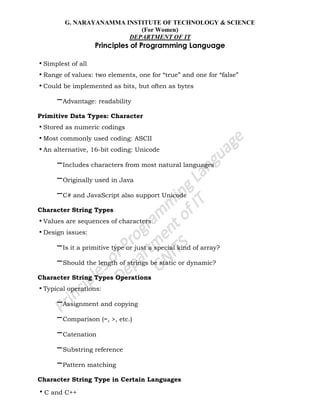





![G. NARAYANAMMA INSTITUTE OF TECHNOLOGY & SCIENCE
(For Women)
DEPARTMENT OF IT
Principles of Programming Language
–C, C++, Java, C# example
int list [] = {4, 5, 7, 83}
–Character strings in C and C++
char name [] = ―freddie‖;
–Arrays of strings in C and C++
char *names [] = {―Bob‖, ―Jake‖, ―Joe‖];
–Java initialization of String objects
String[] names = {―Bob‖, ―Jake‖, ―Joe‖};
Heterogeneous Arrays
•A heterogeneous array is one in which the elements need not be of the same
type
•Supported by Perl, Python, JavaScript, and Ruby
Arrays Operations
•APL provides the most powerful array processing operations for vectors and
matrixes as well as unary operators (for example, to reverse column elements)
•Ada allows array assignment but also catenation
•Python‘s array assignments, but they are only reference changes. Python
also supports array catenation and element membership operations
•Ruby also provides array catenation
•Fortran provides elemental operations because they are between pairs of
array elements
–For example, + operator between two arrays results in an array of the sums of
the element pairs of the two arrays
Rectangular and Jagged Arrays
•A rectangular array is a multi-dimensioned array in which all of the rows
have the same number of elements and all columns have the same number of
elements
•A jagged matrix has rows with varying number of elements
–Possible when multi-dimensioned arrays actually appear as arrays of arrays](https://image.slidesharecdn.com/ppl-150324230515-conversion-gate01/85/Principles-of-programming-languages-Detail-notes-28-320.jpg)

![G. NARAYANAMMA INSTITUTE OF TECHNOLOGY & SCIENCE
(For Women)
DEPARTMENT OF IT
Principles of Programming Language
•Access function for single-dimensioned arrays:
address(list[k]) = address (list[lower_bound])
+ ((k-lower_bound) * element_size)
Accessing Multi-dimensioned Arrays
•Two common ways:
–Row major order (by rows) – used in most languages
–column major order (by columns) – used in Fortran
Locating an Element in a Multi-dimensioned Array
Compile-Time Descriptors](https://image.slidesharecdn.com/ppl-150324230515-conversion-gate01/85/Principles-of-programming-languages-Detail-notes-30-320.jpg)





![G. NARAYANAMMA INSTITUTE OF TECHNOLOGY & SCIENCE
(For Women)
DEPARTMENT OF IT
Principles of Programming Language
program (often called garbage)
•Pointer p1 is set to point to a newly created heap-dynamic variable
•Pointer p1 is later set to point to another newly created heap-dynamic
variable
•The process of losing heap-dynamic variables is called memory leakage
Pointers in Ada
•Some dangling pointers are disallowed because dynamic objects can be
automatically deallocated at the end of pointer's type scope
•The lost heap-dynamic variable problem is not eliminated by Ada (possible
with UNCHECKED_DEALLOCATION)
Pointers in C and C++
•Extremely flexible but must be used with care
•Pointers can point at any variable regardless of when or where it was
allocated
•Used for dynamic storage management and addressing
•Pointer arithmetic is possible
•Explicit dereferencing and address-of operators
•Domain type need not be fixed (void *)
void * can point to any type and can be type
checked (cannot be de-referenced)
Pointer Arithmetic in C and C++
float stuff[100];
float *p;
p = stuff;
*(p+5) is equivalent to stuff[5] and p[5]
*(p+i) is equivalent to stuff[i] and p[i]
Reference Types
•C++ includes a special kind of pointer type called a reference type that is
used primarily for formal parameters](https://image.slidesharecdn.com/ppl-150324230515-conversion-gate01/85/Principles-of-programming-languages-Detail-notes-36-320.jpg)




![G. NARAYANAMMA INSTITUTE OF TECHNOLOGY & SCIENCE
(For Women)
DEPARTMENT OF IT
Principles of Programming Language
The r-value of a variable is its value
Def: A binding is an association, such as between an attribute and an entity, or
between an operation and a symbol
Def: Binding time is the time at which a binding takes place.
Possible binding times:
Language design time--e.g., bind operator symbols to operations
Language implementation time--e.g., bind floating point type to a
representation
Compile time--e.g., bind a variable to a type in C or Java
Load time--e.g., bind a FORTRAN 77 variable to a memory cell (or a C static
variable)
Runtime--e.g., bind a nonstatic local variable to a memory cell
Def: A binding is static if it first occurs before run time and remains unchanged
throughout program execution.
Def: A binding is dynamic if it first occurs during execution or can change during
execution of the program.
Type Bindings
How is a type specified?
When does the binding take place?
If static, the type may be specified by either an explicit or an implicit declaration
Def: An explicit declaration is a program statement used for declaring the types of
variables
Def: An implicit declaration is a default mechanism for specifying types of variables
(the first appearance of the variable in the program)
FORTRAN, PL/I, BASIC, and Perl provide implicit declarations
Advantage: writability
Disadvantage: reliability (less trouble with Perl)
Dynamic Type Binding (JavaScript and PHP)
Specified through an assignment statement e.g., JavaScript
list = [2, 4.33, 6, 8];
list = 17.3;
Advantage: flexibility (generic program units)
Disadvantages:
High cost (dynamic type checking and interpretation)
Type error detection by the compiler is difficult
Type Inferencing (ML, Miranda, and Haskell)
Rather than by assignment statement, types are determined from the context of
the reference
Storage Bindings & Lifetime
Allocation - getting a cell from some pool of available cells
Deallocation - putting a cell back into the pool
Def: The lifetime of a variable is the time during which it is bound to a particular
memory cell](https://image.slidesharecdn.com/ppl-150324230515-conversion-gate01/85/Principles-of-programming-languages-Detail-notes-41-320.jpg)

![G. NARAYANAMMA INSTITUTE OF TECHNOLOGY & SCIENCE
(For Women)
DEPARTMENT OF IT
Principles of Programming Language
type
If all type bindings are static, nearly all type checking can be static
If type bindings are dynamic, type checking must be dynamic
Def: A programming language is strongly typed if type errors are always detected
Strong Typing
Advantage of strong typing: allows the detection of the misuses of variables that
result in type errors
Language examples:
FORTRAN 77 is not: parameters, EQUIVALENCE
Pascal is not: variant records
C and C++ are not: parameter type checking can be avoided; unions are not
type checked
Ada is, almost (UNCHECKED CONVERSION is loophole)
(Java is similar)
Coercion rules strongly affect strong typing--they can weaken it considerably (C++
versus Ada)
Although Java has just half the assignment coercions of C++, its strong typing is
still far less effective than that of Ada
Type Compatibility
Our concern is primarily for structured types
Def: Name type compatibility means the two variables have compatible types if
they are in either the same declaration or in declarations that use the same type
name
Easy to implement but highly restrictive:
Subranges of integer types are not compatible with integer types
Formal parameters must be the same type as their corresponding actual
parameters (Pascal)
Structure type compatibility means that two variables have compatible types if their
types have identical structures
More flexible, but harder to implement
Consider the problem of two structured types:
Are two record types compatible if they are structurally the same but use
different field names?
Are two array types compatible if they are the same except that the subscripts
are different?
(e.g. [1..10] and [0..9])
Are two enumeration types compatible if their components are spelled
differently?
With structural type compatibility, you cannot differentiate between types of
the same structure (e.g. different units of speed, both float)](https://image.slidesharecdn.com/ppl-150324230515-conversion-gate01/85/Principles-of-programming-languages-Detail-notes-43-320.jpg)




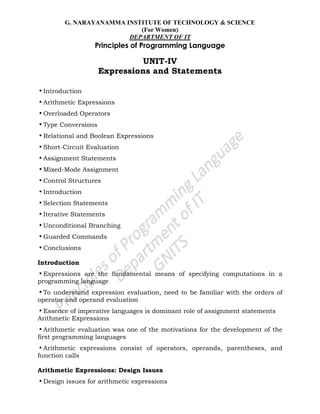




![G. NARAYANAMMA INSTITUTE OF TECHNOLOGY & SCIENCE
(For Women)
DEPARTMENT OF IT
Principles of Programming Language
–Operands are Boolean and the result is Boolean
–Example operators
FORTRAN 77 FORTRAN 90 C Ada
.AND. and && and
.OR. or || or
.NOT. not ! not
xor
Relational and Boolean Expressions: No Boolean Type in C
•C89 has no Boolean type--it uses int type with 0 for false and nonzero for
true
•One odd characteristic of C‘s expressions: a < b < c is a legal
expression, but the result is not what you might expect:
–Left operator is evaluated, producing 0 or 1
–The evaluation result is then compared with the third operand (i.e., c)
Short Circuit Evaluation
•An expression in which the result is determined without evaluating all of the
operands and/or operators
•Example: (13*a) * (b/13–1)
If a is zero, there is no need to evaluate (b/13-1)
•Problem with non-short-circuit evaluation
index = 1;
while (index <= length) && (LIST[index] != value)
index++;
–When index=length, LIST [index] will cause an indexing problem (assuming
LIST has length -1 elements)
Short Circuit Evaluation (continued)
•C, C++, and Java: use short-circuit evaluation for the usual Boolean
operators (&& and ||), but also provide bitwise Boolean operators that are not
short circuit (& and |)
•Ada: programmer can specify either (short-circuit is specified with and then
and or else)
•Short-circuit evaluation exposes the potential problem of side effects in
expressions
e.g. (a > b) || (b++ / 3)](https://image.slidesharecdn.com/ppl-150324230515-conversion-gate01/85/Principles-of-programming-languages-Detail-notes-53-320.jpg)




![G. NARAYANAMMA INSTITUTE OF TECHNOLOGY & SCIENCE
(For Women)
DEPARTMENT OF IT
Principles of Programming Language
•Allow the selection of one of any number of statements or statement groups
•Design Issues:
•What is the form and type of the control expression?
•How are the selectable segments specified?
•Is execution flow through the structure restricted to include just a single
selectable segment?
•How are case values specified?
•What is done about unrepresented expression values?
Multiple-Way Selection: Examples
•C, C++, and Java
switch (expression) {
case const_expr_1: stmt_1;
…
case const_expr_n: stmt_n;
[default: stmt_n+1]
}
•Design choices for C‘s switch statement
•Control expression can be only an integer type
•Selectable segments can be statement sequences, blocks, or compound
statements
•Any number of segments can be executed in one execution of the construct
(there is no implicit branch at the end of selectable segments)
•default clause is for unrepresented values (if there is no default, the whole
statement does nothing)
Multiple-Way Selection: Examples
•C#
- Differs from C in that it has a static semantics rule that disallows the
implicit execution of more than one segment
- Each selectable segment must end with an unconditional branch (goto or
break)
•Ada
case expression is
when choice list => stmt_sequence;](https://image.slidesharecdn.com/ppl-150324230515-conversion-gate01/85/Principles-of-programming-languages-Detail-notes-58-320.jpg)
![G. NARAYANAMMA INSTITUTE OF TECHNOLOGY & SCIENCE
(For Women)
DEPARTMENT OF IT
Principles of Programming Language
…
when choice list => stmt_sequence;
when others => stmt_sequence;]
end case;
•More reliable than C‘s switch (once a stmt_sequence execution is completed,
control is passed to the first statement after the case statement
•Ada design choices:
1. Expression can be any ordinal type
2. Segments can be single or compound
3. Only one segment can be executed per execution of the construct
4. Unrepresented values are not allowed
•Constant List Forms:
1. A list of constants
2. Can include:
- Subranges
- Boolean OR operators (|)
Multiple-Way Selection Using if
•Multiple Selectors can appear as direct extensions to two-way selectors, using
else-if clauses, for example in Python:
if count < 10 :
bag1 = True
elsif count < 100 :
bag2 = True
elif count < 1000 :
bag3 = True
Iterative Statements
•The repeated execution of a statement or compound statement is
accomplished either by iteration or recursion
•General design issues for iteration control statements:
1. How is iteration controlled?
2. Where is the control mechanism in the loop?
Counter-Controlled Loops
•A counting iterative statement has a loop variable, and a means of specifying
the initial and terminal, and stepsize values
•Design Issues:
•What are the type and scope of the loop variable?](https://image.slidesharecdn.com/ppl-150324230515-conversion-gate01/85/Principles-of-programming-languages-Detail-notes-59-320.jpg)
![G. NARAYANAMMA INSTITUTE OF TECHNOLOGY & SCIENCE
(For Women)
DEPARTMENT OF IT
Principles of Programming Language
•What is the value of the loop variable at loop termination?
•Should it be legal for the loop variable or loop parameters to be changed in
the loop body, and if so, does the change affect loop control?
•Should the loop parameters be evaluated only once, or once for every
iteration?
Iterative Statements: Examples
•FORTRAN 95 syntax
DO label var = start, finish [, stepsize]
•Stepsize can be any value but zero
•Parameters can be expressions
•Design choices:
1. Loop variable must be INTEGER
2. Loop variable always has its last value
3. The loop variable cannot be changed in the loop, but the parameters can;
because they are evaluated only once, it does not affect loop control
4. Loop parameters are evaluated only once
•FORTRAN 95 : a second form:
[name:] Do variable = initial, terminal [,stepsize]
…
End Do [name]
- Cannot branch into either of Fortran‘s Do statements
•Ada
for var in [reverse] discrete_range loop ...
end loop
•Design choices:
- Type of the loop variable is that of the discrete range (A discrete range is a
sub-range of an integer or enumeration type).
- Loop variable does not exist outside the loop
- The loop variable cannot be changed in the loop, but the discrete range can;
it does not affect loop control
- The discrete range is evaluated just once
•Cannot branch into the loop body
•C-based languages
for ([expr_1] ; [expr_2] ; [expr_3]) statement](https://image.slidesharecdn.com/ppl-150324230515-conversion-gate01/85/Principles-of-programming-languages-Detail-notes-60-320.jpg)

![G. NARAYANAMMA INSTITUTE OF TECHNOLOGY & SCIENCE
(For Women)
DEPARTMENT OF IT
Principles of Programming Language
•FORTRAN 95 has neither
•Perl and Ruby have two pretest logical loops, while and until. Perl also has
two posttest loops
Iterative Statements: User-Located Loop Control Mechanisms
•Sometimes it is convenient for the programmers to decide a location for loop
control (other than top or bottom of the loop)
•Simple design for single loops (e.g., break)
•Design issues for nested loops
•Should the conditional be part of the exit?
•Should control be transferable out of more than one loop?
Iterative Statements: User-Located Loop Control Mechanisms break and
continue
•C , C++, Python, Ruby, and C# have unconditional unlabeled exits (break)
•Java and Perl have unconditional labeled exits (break in Java, last in Perl)
•C, C++, and Python have an unlabeled control statement, continue, that
skips the remainder of the current iteration, but does not exit the loop
•Java and Perl have labeled versions of continue
Iterative Statements: Iteration Based on Data Structures
•Number of elements of in a data structure control loop iteration
•Control mechanism is a call to an iterator function that returns the next
element in some chosen order, if there is one; else loop is terminate
•C's for can be used to build a user-defined iterator:
for (p=root; p==NULL; traverse(p)){
}
•C#‘s foreach statement iterates on the elements of arrays and other
collections:
Strings[] = strList = {"Bob", "Carol", "Ted"};
foreach (Strings name in strList)
Console.WriteLine ("Name: {0}", name);
- The notation {0} indicates the position in the string to be displayed
•Perl has a built-in iterator for arrays and hashes, foreach
Unconditional Branching](https://image.slidesharecdn.com/ppl-150324230515-conversion-gate01/85/Principles-of-programming-languages-Detail-notes-62-320.jpg)
![G. NARAYANAMMA INSTITUTE OF TECHNOLOGY & SCIENCE
(For Women)
DEPARTMENT OF IT
Principles of Programming Language
•Transfers execution control to a specified place in the program
•Represented one of the most heated debates in 1960‘s and 1970‘s
•Well-known mechanism: goto statement
•Major concern: Readability
•Some languages do not support goto statement (e.g., Java)
•C# offers goto statement (can be used in switch statements)
•Loop exit statements are restricted and somewhat camouflaged goto‘s
Guarded Commands
•Designed by Dijkstra
•Purpose: to support a new programming methodology that supported
verification (correctness) during development
•Basis for two linguistic mechanisms for concurrent programming (in CSP and
Ada)
•Basic Idea: if the order of evaluation is not important, the program should
not specify one
Selection Guarded Command
•Form
if <Boolean exp> -> <statement>
[] <Boolean exp> -> <statement>
...
[] <Boolean exp> -> <statement>
fi
•Semantics: when construct is reached,
–Evaluate all Boolean expressions
–If more than one are true, choose one non-deterministically
–If none are true, it is a runtime error
Selection Guarded Command: Illustrated
Loop Guarded Command
•Form
do <Boolean> -> <statement>
[] <Boolean> -> <statement>
...
[] <Boolean> -> <statement>
od](https://image.slidesharecdn.com/ppl-150324230515-conversion-gate01/85/Principles-of-programming-languages-Detail-notes-63-320.jpg)




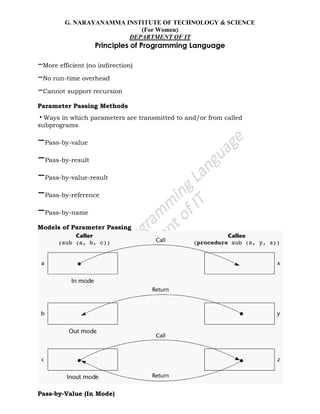







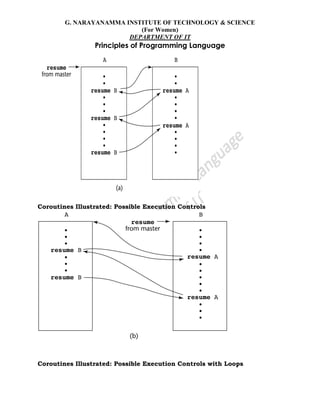
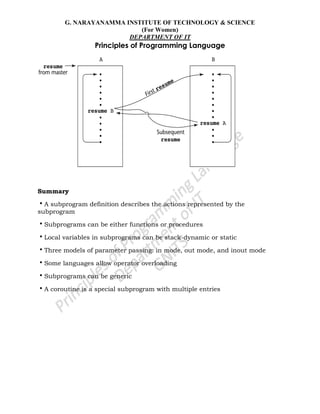



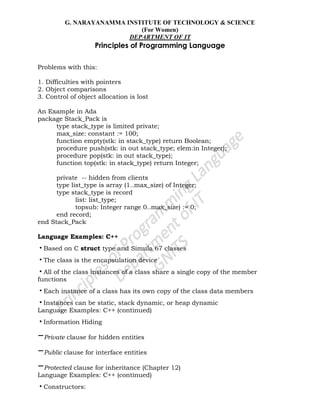
![G. NARAYANAMMA INSTITUTE OF TECHNOLOGY & SCIENCE
(For Women)
DEPARTMENT OF IT
Principles of Programming Language
–Functions to initialize the data members of instances (they do not create the
objects)
–May also allocate storage if part of the object is heap-dynamic
–Can include parameters to provide parameterization of the objects
–Implicitly called when an instance is created
–Can be explicitly called
–Name is the same as the class name
Language Examples: C++ (continued)
•Destructors
–Functions to cleanup after an instance is destroyed; usually just to reclaim
heap storage
–Implicitly called when the object‘s lifetime ends
–Can be explicitly called
–Name is the class name, preceded by a tilde (~)
An Example in C++
class stack {
private:
int *stackPtr, maxLen, topPtr;
public:
stack() { // a constructor
stackPtr = new int [100];
maxLen = 99;
topPtr = -1;
};
~stack () {delete [] stackPtr;};
void push (int num) {…};
void pop () {…};
int top () {…};
int empty () {…};
}
Evaluation of ADTs in C++ and Ada
•C++ support for ADTs is similar to expressive power of Ada](https://image.slidesharecdn.com/ppl-150324230515-conversion-gate01/85/Principles-of-programming-languages-Detail-notes-82-320.jpg)
![G. NARAYANAMMA INSTITUTE OF TECHNOLOGY & SCIENCE
(For Women)
DEPARTMENT OF IT
Principles of Programming Language
•Both provide effective mechanisms for encapsulation and information hiding
•Ada packages are more general encapsulations; classes are types
Language Examples: C++ (continued)
•Friend functions or classes - to provide access to private members to some
unrelated units or functions
–Necessary in C++
Language Examples: Java
•Similar to C++, except:
–All user-defined types are classes
–All objects are allocated from the heap and accessed through reference
variables
–Individual entities in classes have access control modifiers (private or public),
rather than clauses
–Java has a second scoping mechanism, package scope, which can be used in
place of friends
•All entities in all classes in a package that do not have access control
modifiers are visible throughout the package
An Example in Java
class StackClass {
private:
private int [] *stackRef;
private int [] maxLen, topIndex;
public StackClass() { // a constructor
stackRef = new int [100];
maxLen = 99;
topPtr = -1;
};
public void push (int num) {…};
public void pop () {…};
public int top () {…};
public boolean empty () {…};
}
Language Examples: C#
•Based on C++ and Java](https://image.slidesharecdn.com/ppl-150324230515-conversion-gate01/85/Principles-of-programming-languages-Detail-notes-83-320.jpg)

![G. NARAYANAMMA INSTITUTE OF TECHNOLOGY & SCIENCE
(For Women)
DEPARTMENT OF IT
Principles of Programming Language
•C++, Ada, Java 5.0, and C# 2005 provide support for parameterized ADTs
Parameterized ADTs in Ada
•Ada Generic Packages
–Make the stack type more flexible by making the element type and the size of
the stack generic
generic
Max_Size: Positive;
type Elem_Type is private;
package Generic_Stack is
Type Stack_Type is limited private;
function Top(Stk: in out StackType) return Elem_type;
…
end Generic_Stack;
Package Integer_Stack is new Generic_Stack(100,Integer);
Package Float_Stack is new Generic_Stack(100,Float);
Parameterized ADTs in C++
•Classes can be somewhat generic by writing parameterized constructor
functions
class stack {
…
stack (int size) {
stk_ptr = new int [size];
max_len = size - 1;
top = -1;
};
…
}
stack stk(100);
Parameterized ADTs in C++ (continued)
•The stack element type can be parameterized by making the class a
templated class
template <class Type>
class stack {
private:](https://image.slidesharecdn.com/ppl-150324230515-conversion-gate01/85/Principles-of-programming-languages-Detail-notes-85-320.jpg)
![G. NARAYANAMMA INSTITUTE OF TECHNOLOGY & SCIENCE
(For Women)
DEPARTMENT OF IT
Principles of Programming Language
Type *stackPtr;
const int maxLen;
int topPtr;
public:
stack() {
stackPtr = new Type[100];
maxLen = 99;
topPtr = -1;
}
…
}
Parameterized Classes in Java 5.0
•Generic parameters must be classes
•Most common generic types are the collection types, such as LinkedList and
ArrayList
•Eliminate the need to cast objects that are removed
•Eliminate the problem of having multiple types in a structure
Parameterized Classes in C# 2005
•Similar to those of Java 5.0
•Elements of parameterized structures can be accessed through indexing
Summary
•The concept of ADTs and their use in program design was a milestone in the
development of languages
•Two primary features of ADTs are the packaging of data with their
associated operations and information hiding
•Ada provides packages that simulate ADTs
•C++ data abstraction is provided by classes
•Java‘s data abstraction is similar to C++
•Ada, C++, Java 5.0, and C# 2005 support parameterized ADTs
Object-Oriented Programming
•Abstract data types
•Inheritance](https://image.slidesharecdn.com/ppl-150324230515-conversion-gate01/85/Principles-of-programming-languages-Detail-notes-86-320.jpg)

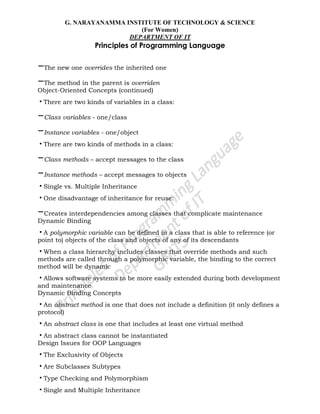


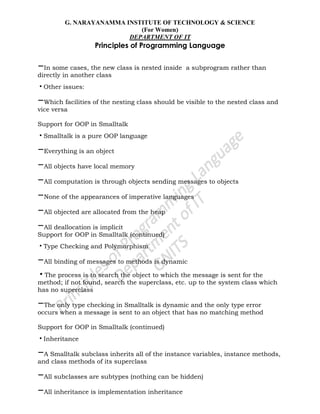






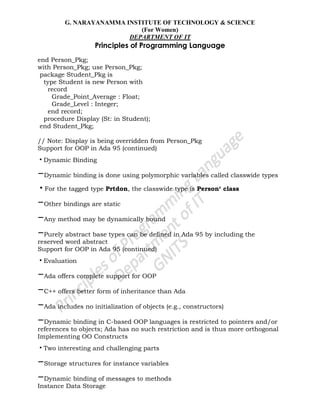






















![G. NARAYANAMMA INSTITUTE OF TECHNOLOGY & SCIENCE
(For Women)
DEPARTMENT OF IT
Principles of Programming Language
•Where does execution continue, if at all, after an exception handler completes
its execution? (continuation vs. resumption)
•Is some form of finalization provided?
Exception Handling Control Flow
Exception Handling in Ada
•The frame of an exception handler in Ada is either a subprogram body, a
package body, a task, or a block
•Because exception handlers are usually local to the code in which the
exception can be raised, they do not have parameters
Ada Exception Handlers
•Handler form:
when exception_choice{|exception_choice} => statement_sequence
...
[when others =>
statement_sequence]
exception_choice form:
exception_name | others
•Handlers are placed at the end of the block or unit in which they occur
Binding Exceptions to Handlers
•If the block or unit in which an exception is raised does not have a handler](https://image.slidesharecdn.com/ppl-150324230515-conversion-gate01/85/Principles-of-programming-languages-Detail-notes-121-320.jpg)
![G. NARAYANAMMA INSTITUTE OF TECHNOLOGY & SCIENCE
(For Women)
DEPARTMENT OF IT
Principles of Programming Language
for that exception, the exception is propagated elsewhere to be handled
–Procedures - propagate it to the caller
–Blocks - propagate it to the scope in which it appears
–Package body - propagate it to the declaration part of the unit that
declared the package (if it is a library unit, the program is terminated)
–Task - no propagation; if it has a handler, execute it; in either case,
mark it "completed"
Continuation
•The block or unit that raises an exception but does not handle it is always
terminated (also any block or unit to which it is propagated that does not
handle it)
Other Design Choices
•User-defined Exceptions form:
exception_name_list : exception;
•Raising Exceptions form:
raise [exception_name]
–(the exception name is not required if it is in a handler--in this case, it
propagates the same exception)
•Exception conditions can be disabled with:
pragma SUPPRESS(exception_list)
Predefined Exceptions
•CONSTRAINT_ERROR - index constraints, range constraints, etc.
•NUMERIC_ERROR - numeric operation cannot return a correct value
(overflow, division by zero, etc.)
•PROGRAM_ERROR - call to a subprogram whose body has not been
elaborated
•STORAGE_ERROR - system runs out of heap
•TASKING_ERROR - an error associated with tasks
Evaluation
•The Ada design for exception handling embodies the state-of-the-art in](https://image.slidesharecdn.com/ppl-150324230515-conversion-gate01/85/Principles-of-programming-languages-Detail-notes-122-320.jpg)
![G. NARAYANAMMA INSTITUTE OF TECHNOLOGY & SCIENCE
(For Women)
DEPARTMENT OF IT
Principles of Programming Language
language design in 1980
•A significant advance over PL/I
•Ada was the only widely used language with exception handling until it was
added to C++
Exception Handling in C++
•Added to C++ in 1990
•Design is based on that of CLU, Ada, and ML
C++ Exception Handlers
•Exception Handlers Form:
try {
-- code that is expected to raise an exception
}
catch (formal parameter) {
-- handler code
}
...
catch (formal parameter) {
-- handler code
}
The catch Function
•catch is the name of all handlers--it is an overloaded name, so the formal
parameter of each must be unique
•The formal parameter need not have a variable
–It can be simply a type name to distinguish the handler it is in from
others
•The formal parameter can be used to transfer information to the handler
•The formal parameter can be an ellipsis, in which case it handles all
exceptions not yet handled
Throwing Exceptions
•Exceptions are all raised explicitly by the statement:
throw [expression];
•The brackets are metasymbols
•A throw without an operand can only appear in a handler; when it appears,
it simply re-raises the exception, which is then handled elsewhere](https://image.slidesharecdn.com/ppl-150324230515-conversion-gate01/85/Principles-of-programming-languages-Detail-notes-123-320.jpg)
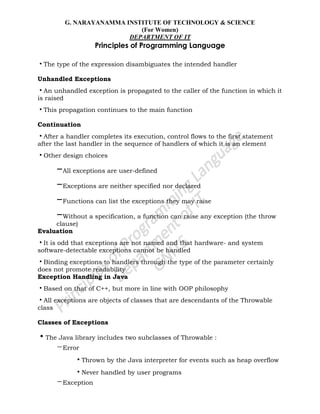





![G. NARAYANAMMA INSTITUTE OF TECHNOLOGY & SCIENCE
(For Women)
DEPARTMENT OF IT
Principles of Programming Language
•Includes lists and list operations
ML Specifics
•Function declaration form:
fun name (parameters) = body;
e.g., fun cube (x : int) = x * x * x;
- The type could be attached to return value, as in
fun cube (x) : int = x * x * x;
- With no type specified, it would default to
int (the default for numeric values)
- User-defined overloaded functions are not allowed, so if we wanted a cube
function for real parameters, it would need to have a different name
- There are no type coercions in ML
•ML selection
if expression then then_expression
else else_expression
where the first expression must evaluate to a Boolean value
•Pattern matching is used to allow a function to operate on different
parameter forms
fun fact(0) = 1
| fact(n : int) : int =
n * fact(n – 1)
•Lists
Literal lists are specified in brackets
[3, 5, 7]
[] is the empty list
CONS is the binary infix operator, ::
4 :: [3, 5, 7], which evaluates to [4, 3, 5, 7]
CAR is the unary operator hd
CDR is the unary operator tl
fun length([]) = 0
| length(h :: t) = 1 + length(t);
fun append([], lis2) = lis2
| append(h :: t, lis2) = h :: append(t, lis2);
•The val statement binds a name to a value (similar to DEFINE in Scheme)
val distance = time * speed;
- As is the case with DEFINE, val is nothing like an assignment statement in](https://image.slidesharecdn.com/ppl-150324230515-conversion-gate01/85/Principles-of-programming-languages-Detail-notes-130-320.jpg)
![G. NARAYANAMMA INSTITUTE OF TECHNOLOGY & SCIENCE
(For Women)
DEPARTMENT OF IT
Principles of Programming Language
an imperative language
Haskell
•Similar to ML (syntax, static scoped, strongly typed, type inferencing, pattern
matching)
•Different from ML (and most other functional languages) in that it is purely
functional (e.g., no variables, no assignment statements, and no side effects of
any kind)
Syntax differences from ML
fact 0 = 1
fact n = n * fact (n – 1)
fib 0 = 1
fib 1 = 1
fib (n + 2) = fib (n + 1) + fib n
Function Definitions with Different Parameter Ranges
fact n
| n == 0 = 1
| n > 0 = n * fact(n – 1)
sub n
| n < 10 = 0
| n > 100 = 2
| otherwise = 1
square x = x * x
- Works for any numeric type of x
Lists
•List notation: Put elements in brackets
e.g., directions = ["north", "south", "east", "west"]
•Length: #
e.g., #directions is 4
•Arithmetic series with the .. operator
e.g., [2, 4..10] is [2, 4, 6, 8, 10]
•Catenation is with ++](https://image.slidesharecdn.com/ppl-150324230515-conversion-gate01/85/Principles-of-programming-languages-Detail-notes-131-320.jpg)
![G. NARAYANAMMA INSTITUTE OF TECHNOLOGY & SCIENCE
(For Women)
DEPARTMENT OF IT
Principles of Programming Language
e.g., [1, 3] ++ [5, 7] results in [1, 3, 5, 7]
•CONS, CAR, CDR via the colon operator (as in Prolog)
e.g., 1:[3, 5, 7] results in [1, 3, 5, 7]
Factorial Revisited
product [] = 1
product (a:x) = a * product x
fact n = product [1..n]
List Comprehension
•Set notation
•List of the squares of the first 20 positive integers: [n * n | n ← [1..20]]
•All of the factors of its given parameter:
factors n = [i | i ← [1..n div 2],
n mod i == 0]
Quicksort
sort [] = []
sort (a:x) =
sort [b | b ← x; b <= a] ++
[a] ++
sort [b | b ← x; b > a]
Lazy Evaluation
•A language is strict if it requires all actual parameters to be fully evaluated
•A language is nonstrict if it does not have the strict requirement
•Nonstrict languages are more efficient and allow some interesting capabilities
– infinite lists
•Lazy evaluation - Only compute those values that are necessary
•Positive numbers
positives = [0..]
•Determining if 16 is a square number
member [] b = False
member(a:x) b=(a == b)||member x b
squares = [n * n | n ← [0..]]
member squares 16
Member Revisited](https://image.slidesharecdn.com/ppl-150324230515-conversion-gate01/85/Principles-of-programming-languages-Detail-notes-132-320.jpg)
![G. NARAYANAMMA INSTITUTE OF TECHNOLOGY & SCIENCE
(For Women)
DEPARTMENT OF IT
Principles of Programming Language
•The member function could be written as:
member [] b = False
member(a:x) b=(a == b)||member x b
•However, this would only work if the parameter to squares was a perfect
square; if not, it will keep generating them forever. The following version will
always work:
member2 (m:x) n
| m < n = member2 x n
| m == n = True
| otherwise = False
Applications of Functional Languages
•APL is used for throw-away programs
•LISP is used for artificial intelligence
–Knowledge representation
–Machine learning
–Natural language processing
–Modeling of speech and vision
•Scheme is used to teach introductory programming at some universities
Comparing Functional and Imperative Languages
•Imperative Languages:
–Efficient execution
–Complex semantics
–Complex syntax
–Concurrency is programmer designed
•Functional Languages:
–Simple semantics
–Simple syntax](https://image.slidesharecdn.com/ppl-150324230515-conversion-gate01/85/Principles-of-programming-languages-Detail-notes-133-320.jpg)









![G. NARAYANAMMA INSTITUTE OF TECHNOLOGY & SCIENCE
(For Women)
DEPARTMENT OF IT
Principles of Programming Language
•Other basic data structure (besides atomic propositions we have already
seen): list
•List is a sequence of any number of elements
•Elements can be atoms, atomic propositions, or other terms (including other
lists)
[apple, prune, grape, kumquat]
[] (empty list)
[X | Y] (head X and tail Y)
Append Example
append([], List, List).
append([Head | List_1], List_2, [Head | List_3]) :-
append (List_1, List_2, List_3).
Reverse Example
reverse([], []).
reverse([Head | Tail], List) :-
reverse (Tail, Result),
append (Result, [Head], List).
Deficiencies of Prolog
•Resolution order control
•The closed-world assumption
•The negation problem
•Intrinsic limitations
Applications of Logic Programming
•Relational database management systems
•Expert systems
•Natural language processing
Summary
•Symbolic logic provides basis for logic programming
•Logic programs should be nonprocedural
•Prolog statements are facts, rules, or goals
•Resolution is the primary activity of a Prolog interpreter
•Although there are a number of drawbacks with the current state of logic](https://image.slidesharecdn.com/ppl-150324230515-conversion-gate01/85/Principles-of-programming-languages-Detail-notes-143-320.jpg)
